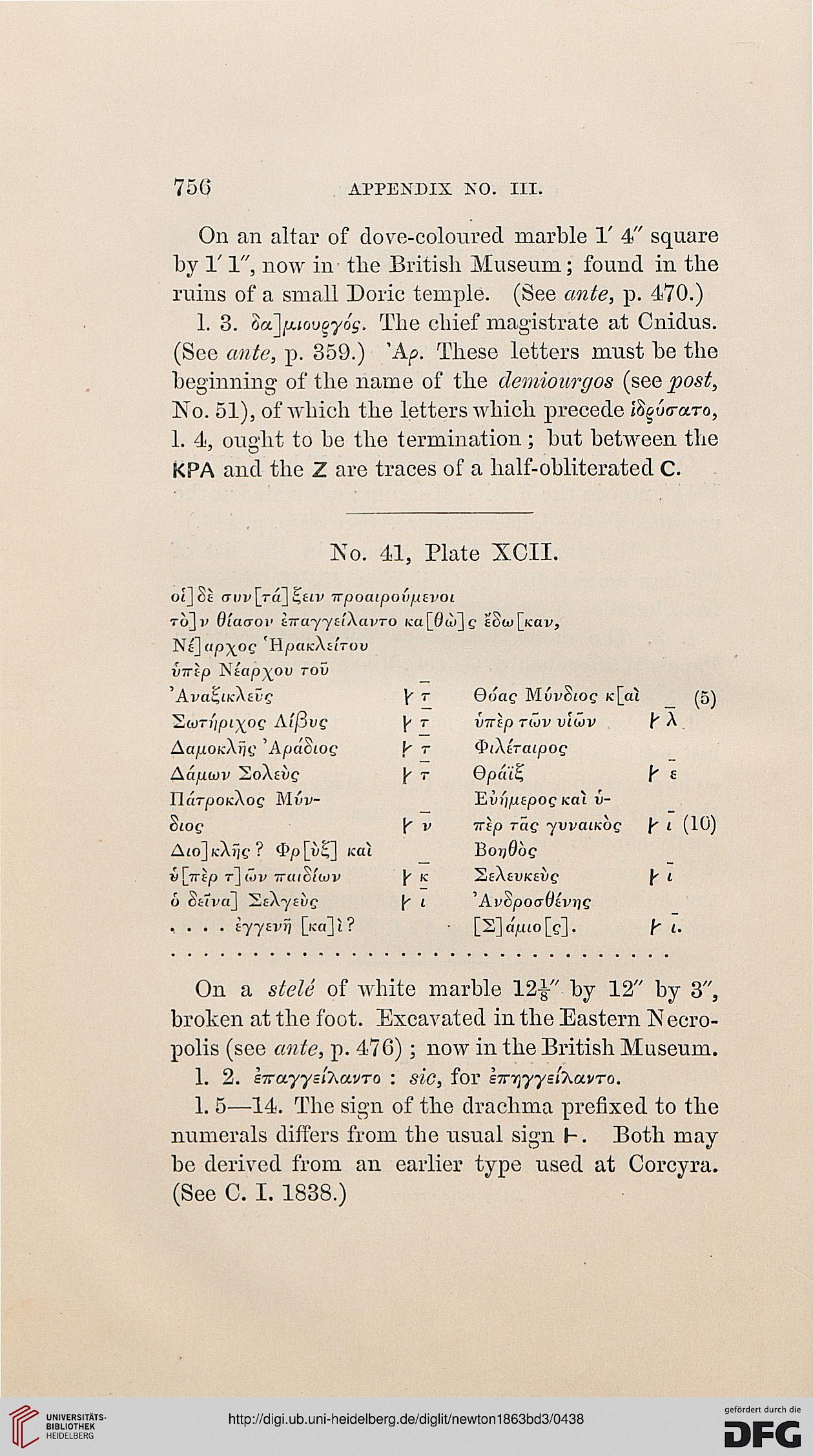756 APPENDIX NO. III.
On an altar of dove-coloured marble 1' 4" square
by 1' 1", now in tbe British Museum; found in the
ruins of a small Doric temple. (See ante, p. 470.)
1. 3. oajixuMoyog. The chief magistrate at Cnidus.
(See ante, p. 359.) 'Ap. These letters must be the
beginning of the name of the demiourgos (see post,
No. 51), of Avhich the letters which precede ll^(xraro,
1. 4, ought to be the termination; but between the
KPA and the Z are traces of a half-obliterated C.
No. 41, Plate XCII.
ot]St avv\TCL]^tlv Trpoaipov/xtvoi
to]v Olaaov tTrayytiXavro Ku[0d>]g £'8a>[icav,
Nt'](ip\0£ 'HjOaKASJTOU
virtp NtapYOU roD
'Ava^iKXevg
\r
Quag MvvStog k[cu
_ (5)
~E.wr)'ipi-\_og Alfivg
yr
v~ip TWV vlwv
YX
AapOKXinj 'ApdStog
V r
<PiXtratpog
Aufiwv ^.oXtvg
Yr
9pai5
P «
YldrpOKXog Mvv-
Ei>r)ju£po£ icai v-
ciog
Y~v
Trcp Tag yvvatKog
Y t (10)
A(o]k-XiJc? $p[iis] icai
BoriObg
v[tt£P t](7jv Tratotiov
Y~k
^eAtvKtvg
P*
6 otTvo] SfAysuc
Y «
'AvdpoaOtvtig
. . . . iyytvTJ [tea] i?
[S]a'/xto[c].
p r.
On a stele of white marble 12|" by 12" by 3",
broken at the foot. Excavated in the Eastern Necro-
polis (see ante, p. 476); now in the British Museum.
1. 2. lirayys'i7\a.vT0 : sic, for eirr^yyaiT^avro.
1. 5—14. The sign of the drachma prefixed to the
numerals differs from the usual sign H. Both may
be derived from an earlier type used at Corcyra.
(See C. I. 1838.)
On an altar of dove-coloured marble 1' 4" square
by 1' 1", now in tbe British Museum; found in the
ruins of a small Doric temple. (See ante, p. 470.)
1. 3. oajixuMoyog. The chief magistrate at Cnidus.
(See ante, p. 359.) 'Ap. These letters must be the
beginning of the name of the demiourgos (see post,
No. 51), of Avhich the letters which precede ll^(xraro,
1. 4, ought to be the termination; but between the
KPA and the Z are traces of a half-obliterated C.
No. 41, Plate XCII.
ot]St avv\TCL]^tlv Trpoaipov/xtvoi
to]v Olaaov tTrayytiXavro Ku[0d>]g £'8a>[icav,
Nt'](ip\0£ 'HjOaKASJTOU
virtp NtapYOU roD
'Ava^iKXevg
\r
Quag MvvStog k[cu
_ (5)
~E.wr)'ipi-\_og Alfivg
yr
v~ip TWV vlwv
YX
AapOKXinj 'ApdStog
V r
<PiXtratpog
Aufiwv ^.oXtvg
Yr
9pai5
P «
YldrpOKXog Mvv-
Ei>r)ju£po£ icai v-
ciog
Y~v
Trcp Tag yvvatKog
Y t (10)
A(o]k-XiJc? $p[iis] icai
BoriObg
v[tt£P t](7jv Tratotiov
Y~k
^eAtvKtvg
P*
6 otTvo] SfAysuc
Y «
'AvdpoaOtvtig
. . . . iyytvTJ [tea] i?
[S]a'/xto[c].
p r.
On a stele of white marble 12|" by 12" by 3",
broken at the foot. Excavated in the Eastern Necro-
polis (see ante, p. 476); now in the British Museum.
1. 2. lirayys'i7\a.vT0 : sic, for eirr^yyaiT^avro.
1. 5—14. The sign of the drachma prefixed to the
numerals differs from the usual sign H. Both may
be derived from an earlier type used at Corcyra.
(See C. I. 1838.)




